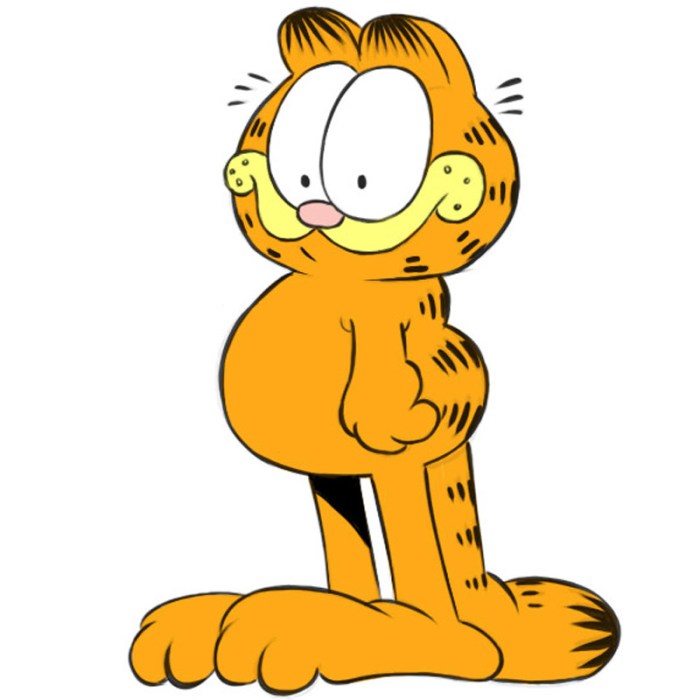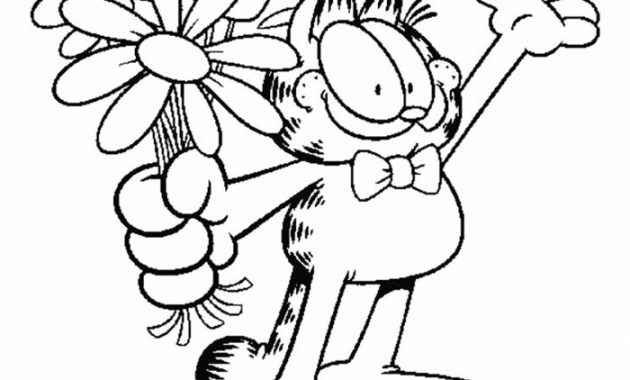Suitable Tracing Resources for Garfield Drawings

Easy garfield drawing trace – Finding the right source image is key to a successful Garfield tracing project. You want something clear, simple, and legally sound. This section will cover suitable resources, methods for finding them, and the legal implications involved.
Mastering an easy Garfield drawing trace is all about finding the right balance between simplicity and detail. Sometimes, though, even the simplest subjects can inspire us to explore other creative avenues. If you’re looking for a different kind of challenge after your Garfield, check out this tutorial for a bullet ant easy drawing – it’s surprisingly satisfying! Then, once you’ve tackled that tiny terror, you can return to your perfectly plump Garfield with newfound appreciation for your skills.
Choosing the right image significantly impacts the ease and quality of your tracing. High-contrast line art is ideal, avoiding overly detailed or complex images that might be challenging for beginners. Furthermore, understanding copyright laws is crucial to avoid legal issues.
Examples of Traceable Garfield Line Art
Here are some examples of Garfield images suitable for tracing, categorized by difficulty. Remember, the complexity of the image directly relates to the time and skill required for tracing.
| Image Description | Source | Difficulty Level |
|---|---|---|
| Simple, black and white line drawing of Garfield sitting, showing only his basic features. | Public domain clip art website (example only, a specific site isn’t named to avoid endorsing any particular site.) | Beginner |
| Slightly more detailed line art of Garfield sleeping, including some shading lines. | Fan art found on a reputable online art community (example only). Attribution is crucial if used. | Intermediate |
| Complex image of Garfield with Jon Arbuckle, featuring detailed backgrounds and multiple characters. | (Not recommended for tracing by beginners) Potentially from a Garfield comic strip (but using copyrighted material without permission is illegal). | Advanced |
| A simplified version of a classic Garfield comic panel, focusing on Garfield’s Artikel and key features. | Created by simplifying a publicly available comic panel image. (Requires editing skills to simplify the image for easier tracing) | Intermediate |
Methods for Finding High-Quality Source Images
Several strategies can help you find suitable Garfield images for tracing. Prioritizing clarity and simplicity is key for beginners.
Search for “Garfield line art,” “Garfield simple drawing,” or “Garfield clip art” on image search engines. Filter your results by image type (line art or vector graphics) to refine your search and find images with clean lines. Explore public domain image websites, but always double-check the license before using any image.
Legal Aspects of Using Copyrighted Garfield Images
Using copyrighted Garfield images without permission is illegal. Copyright protects original creative works, including the Garfield comic strip characters and artwork. Tracing a copyrighted image for personal use might be permissible under fair use principles in some limited circumstances, but using it for commercial purposes is almost certainly a violation. It’s safer to stick to public domain images or create your own artwork.
To avoid legal issues, stick to public domain images or create your own drawings inspired by Garfield. Remember, copyright infringement can lead to legal action and penalties.
Step-by-Step Guide to Finding Appropriate Tracing Resources
This guide provides a structured approach to finding suitable images for tracing, ensuring a smooth and legally compliant process.
- Identify your skill level: Beginners should start with simple line art. More advanced tracers can tackle more complex images.
- Refine your search terms: Use specific s like “Garfield simple line art,” “Garfield black and white,” or “Garfield vector art” to target suitable images.
- Check image licenses: Always verify the license associated with an image before using it. Look for Creative Commons licenses that allow for reuse, or stick to public domain resources.
- Assess image quality: Choose images with clear, defined lines. Avoid images that are blurry, pixelated, or overly complex.
- Consider image size: Select an image size appropriate for your project. Larger images provide more detail but require more tracing effort.
Tracing Techniques and Tools: Easy Garfield Drawing Trace

Tracing Garfield, or any cartoon character for that matter, is a great way to learn about linework, proportions, and overall composition. It’s a fantastic stepping stone to developing your own drawing skills. This section will cover various techniques and tools to make your tracing experience smooth and effective.Tracing offers a low-pressure way to practice replicating existing artwork, improving hand-eye coordination and understanding how lines create form.
You’ll be surprised how much you learn by carefully following the contours of a pre-existing image. Don’t worry about making it perfect on your first try; the goal is to learn and have fun!
Tracing Techniques for Beginners
Several techniques are well-suited for beginners. The simplest involves placing your tracing paper over the Garfield image and lightly tracing the Artikels with a pencil. This method allows for corrections and adjustments. Another technique, ideal for more intricate details, uses a lightbox or window. This allows you to see the original image clearly while tracing.
For digital tracing, you can use software like Photoshop or Krita to import your Garfield image and trace over it using a digital pen or mouse. Experiment to find the method that feels most comfortable.
Tools for Tracing Garfield Drawings
The tools you’ll use significantly impact the outcome of your tracing. Pencils, particularly H2 or HB, offer a light touch and are easily erasable, perfect for beginners. Pens, such as fine-liners or technical pens, provide sharper, more defined lines once you feel more confident. For digital tracing, a graphics tablet with a stylus provides a natural drawing experience, mirroring the feel of a pen on paper.
A standard computer mouse can also work, though it offers less precision.
Advantages and Disadvantages of Tracing Methods
Each tracing method presents unique advantages and disadvantages. Traditional pencil tracing on paper is readily accessible, inexpensive, and forgiving; mistakes are easily corrected. However, it can be challenging to achieve fine details. Lightbox tracing offers better visibility of the original image, resulting in more accurate tracing. However, it requires additional equipment.
Digital tracing offers unparalleled precision and the ability to easily adjust and modify the traced image. However, it requires familiarity with digital art software and hardware.
Materials Needed for Tracing Garfield Drawings, Easy garfield drawing trace
To successfully trace your Garfield drawings, gather these materials:
- A printed image of Garfield.
- Tracing paper (various weights are available, experiment to find your preference).
- Pencils (HB or 2H are recommended).
- Eraser.
- Optional: Lightbox or a brightly lit window.
- Optional: Fine-liner pens or technical pens for inking.
- Optional: Graphics tablet and stylus (for digital tracing).
- Optional: Digital art software (Photoshop, Krita, etc.).
Questions and Answers
What kind of paper is best for tracing Garfield?
Smooth drawing paper or cartridge paper works well for tracing. Avoid papers that are too rough, as they can make tracing difficult.
Can I trace Garfield from a screen?
Yes, you can use a lightbox or place your tracing paper over a brightly lit screen. However, using a printed image is generally easier.
What if I make a mistake while tracing?
Don’t worry! Lightly erase mistakes and try again. Practice makes perfect!
Are there any free Garfield images I can use for tracing?
Always check for copyright restrictions before using any image. Some websites offer free-to-use images, but be sure to verify the license.

